News //
The South Java Deep Sea Biodiversity Expedition of SJADES 2018 kicked off on 23rd March, sailing off in the BARUNA JAYA 8 on the evening tide. The first four days were spent in the Sunda Straits between the islands of Sumatra and Java, and facing the open Indian Ocean. The time was used to good effect to fine-tune procedures, test the equipment with the crew and team, and ensuring the specimens are well handled when collected.
Mother Nature, however, was not kind to us. The seas were choppy, it was raining and the boat was rocking badly – we were suffering the tailwind effects of a cyclone much further south. It was a testing time as half the team (including both chief scientists!) was sea-sick on the first day. And we had to work a 16-hour shift as we had much to do. But the excitement of trying to catch deep-sea animals was palpable and everyone persevered. We survived the storm – literally and figuratively. But the anticipation of success is a wonderful tonic for seasickness and tiredness.
And we were successful. In the first few days, the dredges, trawls and corers entered depths of almost 1000 metres, collecting many strange animals. Many of the scientists on board have never handled deep-sea animals before, and all were extremely excited each time the catch came up. More so that some animals were still alive! It was amusing to see grown women and men jumping around in excitement like kids in a toy shop! While all the scientists have seen photographs of these animals, it is very different to see them in the flesh – and they have literally, out of this world appearances (see below). They are indeed aliens from the deep!
The fourth day (26th March) was a bonanza for the team as the skills got honed. In the waters between the Sunda Strait and Indian Ocean, the team trawled to depths of almost 1600 m and we obtained many strange animals for the first time. This included a new infraclass of sea stars, giant sea cucumbers, bizarre glass sponges, new species of spider crabs, strange new hermit crabs, and arguably the catch of the day was a 30 cm long giant isopod! We will share the details of these discoveries with all very soon!
Surprisingly, the entry into the main Indian Ocean itself on the fifth day was somewhat of an anti-climax as the waters got calmer and the weather got better. That being said, sampling got trickier as the terrain was more rugged and the maps were not always reliable. As such, sampling at depths of 1000 metres got more difficult. Some trawls and cores failed completely. But this we expected – sampling in an area that has never been sampled before for bottom-dwelling animals is not easy. But we did not do too badly – as of 30th March, the team has logged 36 stations. Of these, only three were considered failures.
The Singaporean expedition leader, Prof Ng notes that, “The expedition team has gelled together very well and by the second day, things were already coming along smoothly. The collections so far have uncovered a large number of scientifically important species, including many new records for Indonesia and the region. It has been singularly exciting. I am particularly happy of course with my crabs and my cool “Darth Vader” isopod!”
The Indonesian expedition leader, Prof Rahayu was delighted – she has already found dozens of new and unexpected deep-water hermit crabs (her research speciality) and even hatched out the eggs of one strange species that lives in rotten wood! She comments “The discoveries have been overwhelming and exciting! We have found many things we never imagined were living down there – and they are all Indonesian animals! We must find more – especially hermit crabs of course!”
And we now enter the second half of the expedition with renewed vigour and anticipation! Stay tuned!
  |
Ice Cream Cone Worm This is NOT an ice cream cone you lick. This 6 cm deep-sea tube-dwelling worm (Family Pectinariidae) pastes sediment grains with their tentacles to the pre-existing conical tube as they grow, forming a structure which resembles an ice cream cone. These worms have a characteristic set of golden paleae (spines) surrounding the mouth, which they use for digging into soft sediments. Depth: from 300 m. |
  |
Swimming Cucumber Most people see sea cucumbers as sluggish bottom dwelling animals but in the deep-sea, they are not just beautiful – they are also very athletic. This one (Pelagothuria sp., Family Pelagothuridae) actually swims from one place to another using huge papillae on the back of its mouth! This way, it can search for richer feeding grounds! Size 10-15 cm. Depth: from 800 m. |
  |
Elephants in the Sea? This is not a pile of confiscated elephant tusks! These are actually Tusk Shells or scaphopods (Family Dentaliidae) and were trawled off deep waters in southern Java where it is common. Scaphopods form a separate group of molluscs distinct from the more familiar snails, clams, and squid, and are open at both ends to allow respiration and feeding. They mostly feed on benthic foraminiferans using long, sticky, thread-like ‘fingers’ known as captaculae. Size: 4-8 cm. Depth: from 300 m. |
  |
A Most Peculiar Scallop This deep sea scallop (Propeamussium sp., Family Pectenidae) is way too small to eat at only 2 cm across but as with all deep-sea animals, it has some peculiar habits. Scientists believe it is carnivorous, feeding on very small animals! In addition, it almost has a sea anemone attached to one of its valves – presumably for protection. Size: 2-3 cm. Depth: from 500 m. |
 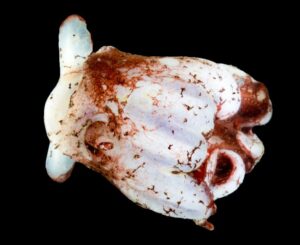 |
Dumbo Nicknamed the Dumbo Octopus (Family Opisthoteuthidae) because of its resemblance to a beloved Disney character, this specimen was trawled from about 900 m off the coast of southwest Java. The entire animal has a jelly-like feel to it and is coloured dark purple when first observed in the trawl net. It swims using two large flaps on its head! Size: 15-20 cm. |
 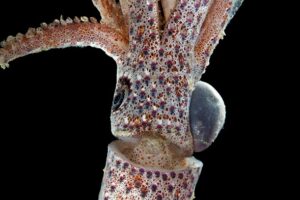 |
Cock-Eyed Squid This peculiar squid (Family Histieuthidae) measuring some 8 cm actually has one eye naturally much larger than the other. It apparently swims with the larger eye looking downwards for food, whilst the smaller eye peers upwards, presumably on the lookout from predators. From 300 m. |
 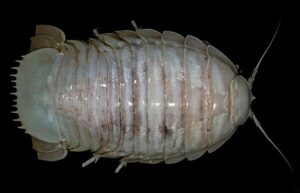 |
Darth Vader of the Seas The famous Giant Sea isopod, Bathynomus (Family Cirolanidae). The expedition found at least two species, one of which is almost 30 cm in length. These are important deep-sea scavengers but the surprise was they have not been officially recorded from Indonesia before! And the giant species feature here seems to be new to science as well! From 800 m. |
 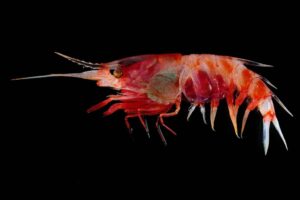 |
Blood Shrimp A spectacularly coloured shrimp that was caught alive! Oplophorus gracilirostris (Family Oplophoridae) regurgitates a bioluminescent cloud to confuse predators when disturbed! This is a habit shared with several commercial species of deep-sea prawns! From 600 metres. |
  |
Chain-Saw Lobster Nick-named the chain-saw lobster, Thaumastocheles massonktenos (Family Thaumastochelidae). This is a rare deep sea blind lobster with scary right claws lined with many sharp teeth. Scientists, however, suspect that scary-looking claw is not a predatory device but acts to sieve bottom substrates for small animals to eat. These lobsters are rarely collected because they dig deep burrows. From 500 metres. |
 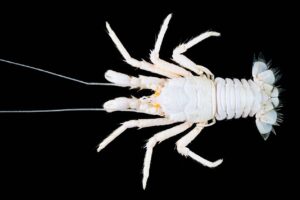 |
Snow White The deep sea Munidopsis nitida (Family Galatheidae) is a squat lobster is ghostly white (the team has dubbed it the snow white crab!). It lives on sunken wood, an important deep-sea habitat, and is believed to also feed on the rotting wood! Size: 4 cm. Depth: from 800 metres. |
  |
Deep Sea Decorator Crab A new species of deep-sea decorator crab of the genus Tunepugettia (Family Epialtidae), one of the more than 30 crab species found so far. These crabs place all manner of objects on the rows of hairs on their body to camouflage themselves from predators as they scavenge for food in the ocean bottom. Size: 5 cm long. Depth: from 400-800 m. |
  |
Tripod Wonder The deep-sea tripod fish (Bathypterois sp., Family Ignopidae) is strange all round. It has peculiar fins and filaments by which it balances itself on soft bottoms and to help it detect small prey swimming past as it faces the current. It has eyes which have no lenses so its unable to focus on objects. And last but not least, they are hermaphrodites – i.e. individuals are both male and female! An amazing trifecta of odd features to help survive in perpetual darkness. Size 20 cm. Depth: from about 900 m. |
  |
Fang Tooth When you live in the deep sea, food is hard to come by. So if you encounter a tasty shrimp or fish, you must ensure it does not escape your grasp. The aptly named Fang Tooth (Anoplogaster cornuta, Family Anoplogastridae) does this with wicked looking long teeth. No escape for any prey if it happens to get into this mouth! Size: 10 cm. Depth: from 500 m. |
  |
Oddball Hermit A discovery that excited the researchers on board is the second species of hermit crab found living in a solitary coral. The solitary coral (Heteropsommia sp.) was previously only known to have a commensal relationship with a sipunculid worm. Size: 1.5 cm. Depth: 200 m. |
 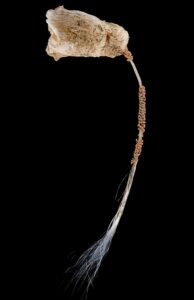 |
City of Glass The actual glass sponge (Hyalonema sp., Family Hyalonemidae) itself is the blob on top which resembles a tulip (hence its common name of Sea Tulip) and is supported by a twisted tuft of glass fibres which is anchored to the seabed. In life, the “tulip” sways side to side with the current, filtering the seawater for organic matter. Size: 1 metre. Depth: 300-2000 m. |